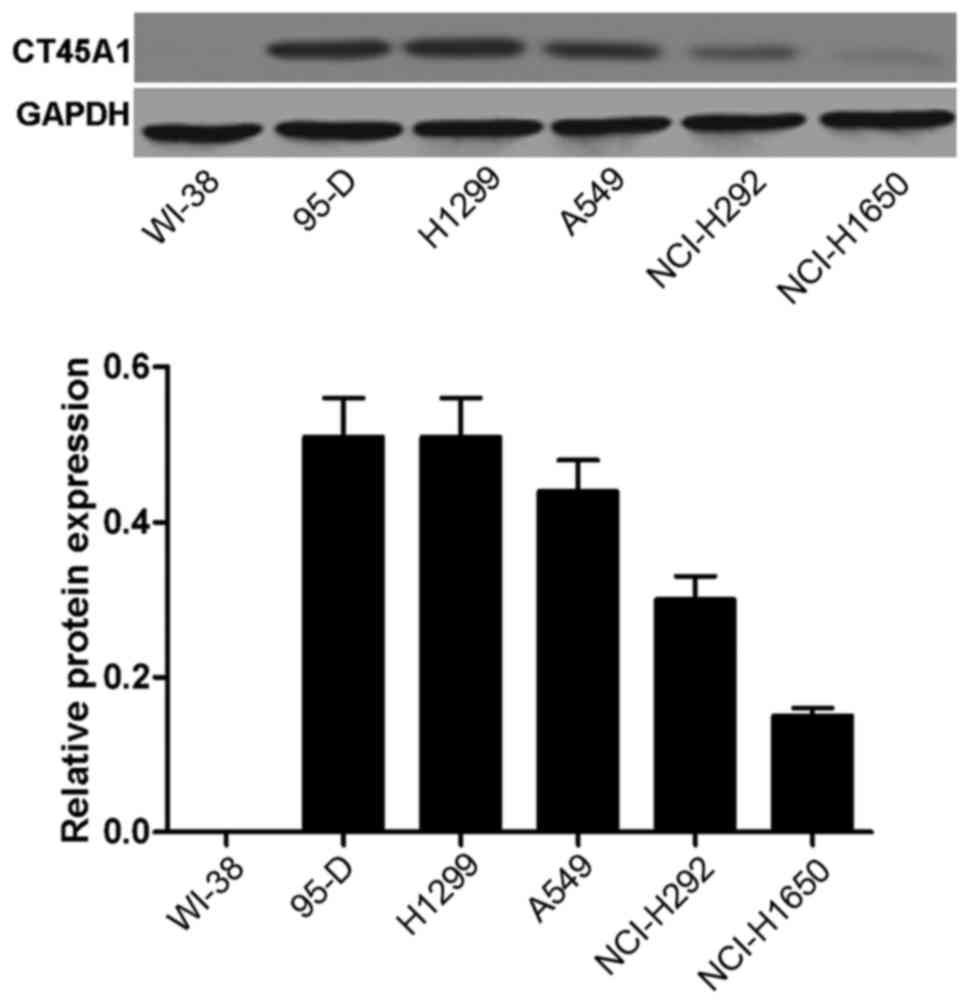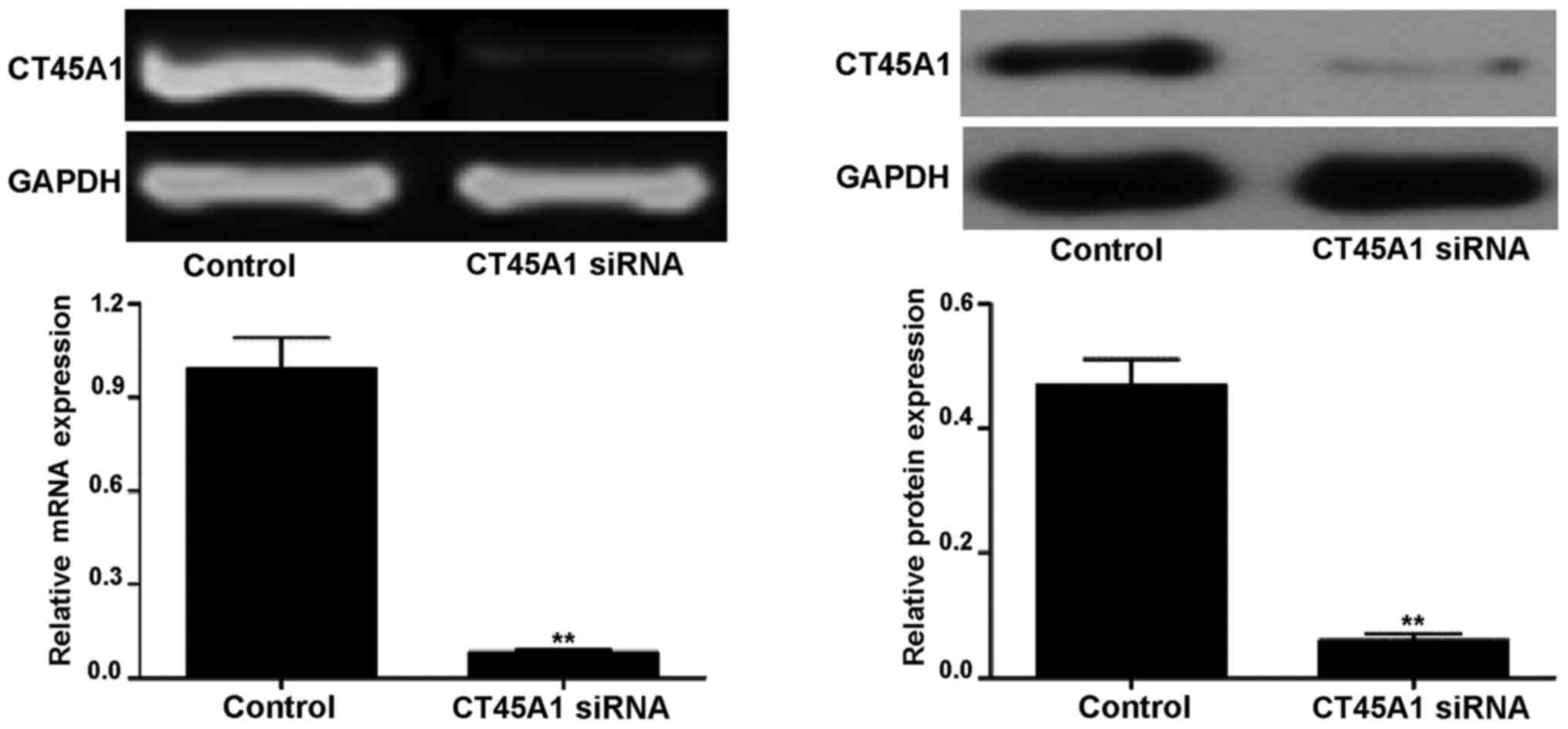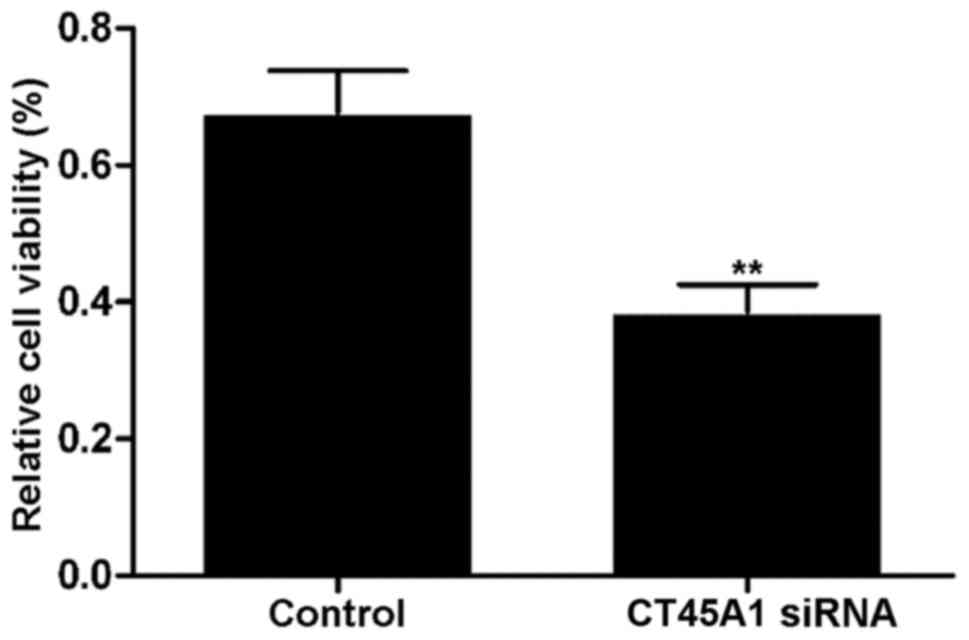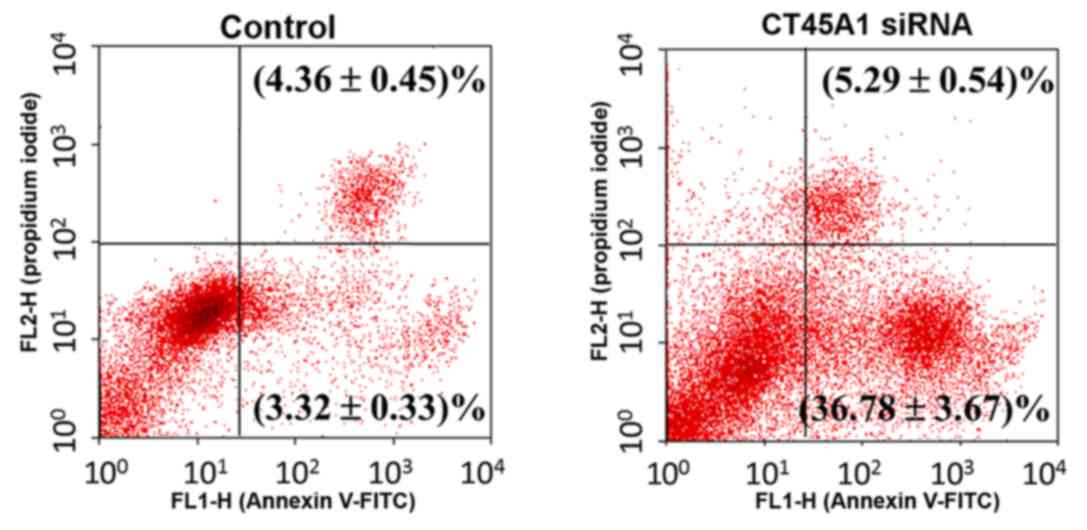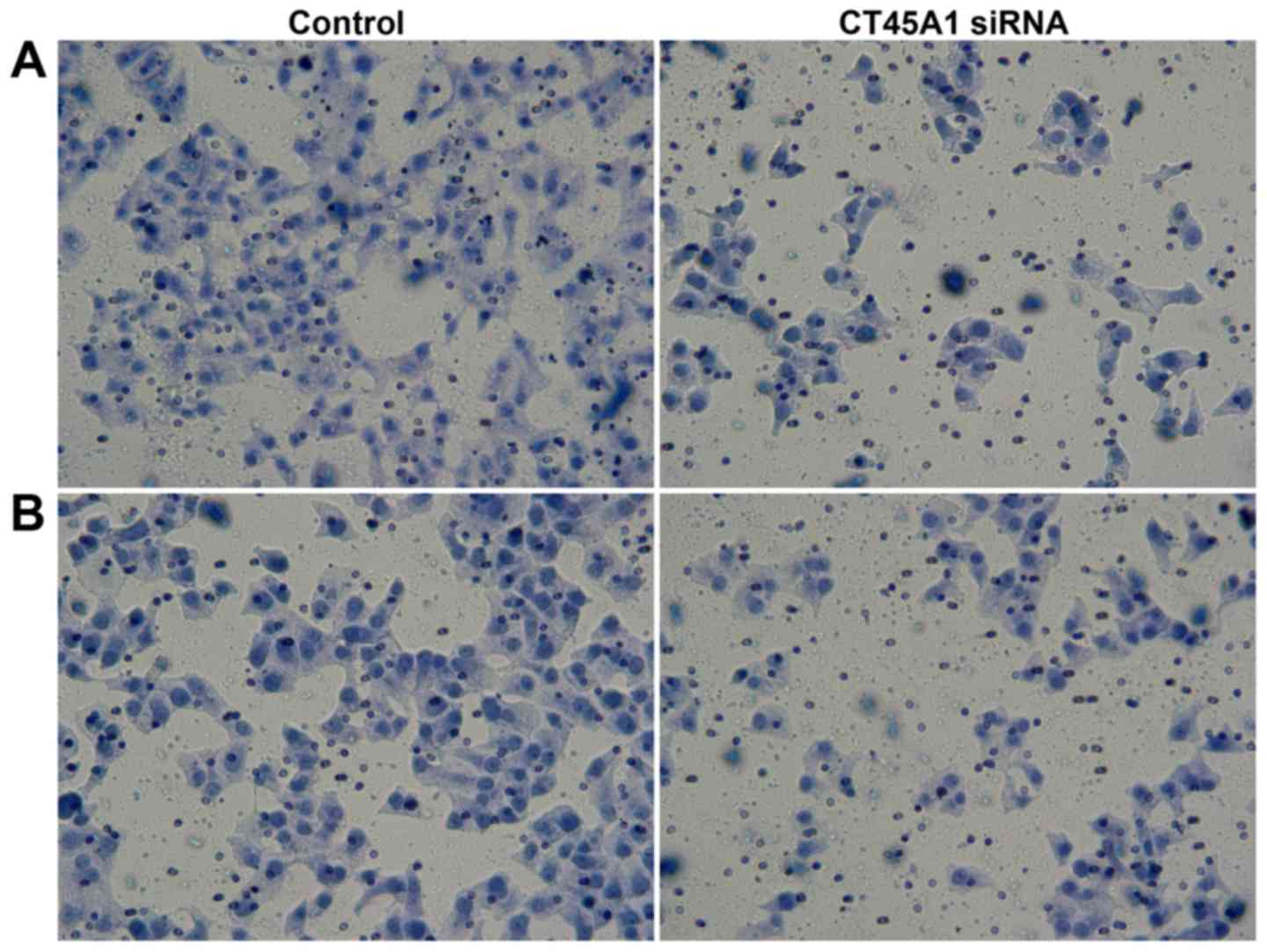CT45A1 siRNA silencing suppresses the proliferation, metastasis and invasion of lung cancer cells by downregulating the ERK/CREB signaling pathway
- Authors:
- Published online on: September 12, 2017 https://doi.org/10.3892/mmr.2017.7466
- Pages: 6708-6714
-
Copyright: © Tang et al. This is an open access article distributed under the terms of Creative Commons Attribution License.
Abstract
Introduction
Lung cancer is a serious public health concern and has become the leading cause of mortality among all malignant carcinomas worldwide with the rates of morbidity and mortality increasing each year. At present, the main treatment available to patients with lung cancer is surgery combined with chemotherapy, radiotherapy and targeted therapy. However, the 5-year patient survival rate is <15%. Lung cancer mortalities in China accounts for ~1/6 of the worldwide mortality rate (1,2).
In the majority of cases, lung cancer is detected and diagnosed in the advanced stages. At this stage, invasion and migration of lung cancer has occurred, and bone and brain metastases are easily developed; however, the specific underlying mechanisms remain unclear (3). A number of researches have indicated that like many other carcinomas, the development and progression of lung cancer is closely associated with diverse gene alterations including chromosome deficiency, gene amplification, oncogene activation, loss of tumor suppressor genes and alterations in apoptosis-associated genes; these abnormities can induce tumorigenesis (3,4). In normal tissues and cells, the levels of oncogenes are normal however, in the tumor environment, oncogenes are mutated and/or constitutively activated, inducing tumorigenesis.
Recent studies have revealed that, as pro-oncogenes, cancer-testis antigens (CTAs) promote the development and progression of tumors (5–8). As testicular tissue-specific genes, CTAs are only expressed in normal testicular tissues and not in other normal tissues; however, they may be abnormally overexpressed in lung, gastric, liver, breast, lymphoma and prostate cancers (5–8). CTAs exhibit strong immunogenicity and thus, have been applied in clinical tumor immunotherapy (5–8). Over 20 CTAs or CTA families, including the CT45 family, have been reported. The CT45 family consists of six genes, CT45A1 to CT45A6. CT45A1 is a pro-oncogene, which has been proposed as a novel transcriptional activator (7,8). Chen et al (9) demonstrated that CT45A1 was positively expressed in patients with lung cancer. Gao (10) further reported that CT45A1 was overexpressed in lung cancer cells and that the overexpression or gene silencing of CT45A1 markedly promoted or inhibited the proliferation, invasion and migration of lung cancer cells, respectively. However, the underlying molecular mechanisms are unknown.
Therefore, in the present study, CT45A1 was targeted by RNA interference in order to investigate the effect of CT45A1 gene silencing on the proliferation, migration and invasion of lung cancer cells, and the mechanisms involved. The present results revealed that CT45A1 influenced the proliferation, metastasis and invasion of lung cancer cells, via regulating the extracellular signal-regulated kinase (ERK)/cyclic AMP response element binding protein (CREB) signaling pathway. These may provide theoretical a basis for the clinical application of CT45A1.
Materials and methods
Materials and cell culture
Rabbit anti-B-cell lymphoma-2 (Bcl-2; cat. no. ab32124), anti-Bcl-2 associated X (Bax; cat. no. ab32503), anti-survivin (cat. no. ab76424), anti-matrix metalloproteinase 2 (MMP2; cat. no. ab37150), anti-MMP9 (cat. no. ab38898), anti-ERK1/2 (cat. no. ab126423), anti-phosphorylated ERK1/2 (p-ERK1/2) (cat. no. ab200807), anti-CREB (cat. no. ab31387), anti-p-CREB (cat. no. ab32096) and anti-GAPDH (cat. no. ab8245) monoclonal antibodies were purchased from Abcam (Cambridge, MA, USA). Rabbit anti-CT45A1 (cat. no. ab170339) polyclonal antibody was purchased from Abcam. Methyl thiazolyl tetrazolium (MTT) was purchased from Hyclone; GE Healthcare Life Sciences (Logan, UT, USA). The horseradish peroxidase-labeled goat anti-rabbit IgG (H+L) antibody (cat. no. A0208), the bicinchoninic acid (BCA) kit and the Annexin V-FITC/propidium iodide (PI) apoptosis detection kit were obtained from Beyotime Institute of Biotechnology (Jiangsu, China). The Transwell insert and TRIzol® were purchased from Invitrogen; Thermo Fisher Scientific, Inc. (Waltham, MA, USA). CT45A1 siRNA (5′-GGAGAGAAAAGGAUCAGAUU-3′) and its negative control (5′-UGCAGUCAGGAAGCGAUUU-3′) were prepared by Shanghai GeneChem Co., Ltd. (Shanghai, China).
The human lung cancer cell lines (NCI-H292, 95-D and H1299), human non-small cell lung cancer cell lines (A549 and NCI-H1650), SPC-A-1 human lung adenocarcinoma cell line and WI-38 human fetal lung cell line were obtained from the Type Culture Collection of the Chinese Academy of Sciences (Shanghai, China). Cells were cultured in RPMI-1640 medium (Hyclone; GE Healthcare Life Sciences) supplemented with 10% (v/v) fetal bovine serum (FBS; Hyclone; GE Healthcare Life Sciences) at 37°C in a 5% CO2 atmosphere.
CT45A1 levels
Prior to siRNA transfection, CT45A1 levels in the various cells were evaluated by western blotting. Following siRNA transfection, the level of CT45A1 in A549 cells was determined by semi quantitative reverse transcription-polymerase chain reaction (RT-PCR) and western blotting. The methodology for these procedures is described in the following sections.
Cell transfection
Lipofectamine 2000 (Thermo Fisher Scientific, Inc.), CT45A1 siRNA and its negative control were each diluted with Opti-MEM® I reduced-serum medium (Gibco; Thermo Fisher Scientific, Inc.). Then, the CT45A1 siRNA and its negative control were each mixed with Lipofectamine 2000 to a final concentration of 50 nmol for 30 min at room temperature. The mixture was added to A549 cells at 50% confluence in 96-well or 6-well plates. Following 6 h, the medium was replaced by RPMI-1640 medium containing 10% (v/v) FBS (Hyclone; GE Healthcare Life Sciences). Following incubation for 48 h at 37°C and 5% CO2, cells were used in the subsequent experiments.
Cell viability
A549 cells were seeded in 96-well plates and transfected with CT45A1 siRNA and its negative control as described above. Following 48 h, 20 µl MTT (5 mg/ml) was added to each well. Following incubation for 4 h, the culture media was discarded and 150 µl of dimethyl sulfoxide was added to each well. Once the crystals were fully dissolved with dimethyl sulfoxide (Beyotime Institute of Biotechnology) under gentle agitation, absorbance was determined at 560 nm on a microplate reader (Infinite F200/M200; Tecan Group Ltd., Männedorf, Switzerland). Untreated cells served as the control and the relative cell viability was calculated.
Cell apoptosis
A549 cells were seeded in 6-well plates and transfected with CT45A1 siRNA and its negative control as described. Following 48 h, cells were stained using the Annexin V-FITC/PI apoptosis detection kit according to the manufacturer's instructions. Then, the cells were assessed within 1 h on a flow cytometer (FACSCanto; BD Biosciences, Franklin Lakes, NJ, USA) with using the FACSCanto clinical software (BD Biosciences).
Cell migration
A549 cells were seeded in 6-well plates and transfected with CT45A1 siRNA and its negative control. Following 48 h, ~8,000 cells were collected and transferred into the upper chamber of the Transwell insert in serum-free RPMI-1640 medium and RPMI-1640 medium containing 10% (v/v) FBS was added into the lower chamber of the Transwell insert. Cells were incubated for 48 h. The Transwell insert was taken out and the cells above the membrane were carefully removed using cotton swabs. Then, the membrane was fixed in 4% paraformaldehyde at room temperature for 5 min and stained with 0.1% crystal violet at room temperature for 5 min. Cells in the lower chamber in five visual fields were counted using a light microscope (Eclipse TS100; Nikon Corporation, Tokyo, Japan). The migration capacity of cells was expressed as the average number of cells in every field of view.
Cell invasion
Matrigel was first uniformly distributed onto the membrane (5-µm) of Transwell inserts in advance to prepare gel. For the Transwell assay the chambers were prepared and the cells were treated as described above. The invasion capacity of cells was also expressed as the average number of cells in every field of view.
RT-PCR
Total RNA was obtained using TRIzol® according to the manufacturer's instructions; RNA purity was determined with an ultraviolet spectrophotometer (NanoDrop 2000C; Thermo Fisher Scientific, Inc.). RNA was reverse transcribed into cDNA and cDNA was amplified using the SuperScript One-Step RT-PCR kit (Thermo Fisher Scientific, Inc.) according to the manufacturer's instructions. Primers (Table I) were added into the PCR system (total volume, 25 µl) and the PCR reaction parameters were set as follows: 35 cycles of denaturation for 45 sec at 94°C, annealing for 45 sec at 59°C and elongation for 60 sec at 72°C. The obtained amplification product (5 µl) was loaded for 2% agarose gel electrophoresis (w/v) and stained with 5 µl GoldView dye (Phygene Life Sciences, Fujian, China). Electrophoresis strips were photographed and analyzed on a gel imaging system (ChemiDoc™ XRS; Bio-Rad Laboratories, Inc., Hercules, CA, USA) using ImageJ software version 1.38e (National Institutes of Health, Bethesda, MD, USA).
Western blot analysis
Lung cancer cells were seeded in 6-well plates. For evaluation following transfection, cells were transfected with CT45A1 siRNA and its negative control as described. Following 48 h, cells were collected and lysed in radioimmunoprecipitation buffer (Beyotime Institute of Biotechnology) for 30 min. Cell lysates were centrifuged at 7,000 × g and 4°C for 10 min and the supernatant was collected to acquire total protein. Protein content was determined using a bicinchoninic acid protein assay kit according to the manufacturer's instructions, then protein was denatured for 10 min and 30 ng protein samples were separated by 10% SDS-PAGE. Proteins were transferred to a polyvinylidene difluoride membrane using the wet transfer method. The membrane was blocked with 5% non-fat milk for 1 h at room temperature and then incubated with the primary antibodies (rabbit anti-Bax, anti-Bcl-2, anti-survivin, anti-MMP2, anti-MMP9, anti-ERK1/2, anti-p-ERK1/2, anti-CREB, anti-p-CREB and anti-GAPDH monoclonal antibodies, and rabbit anti-CT45A1 polyclonal antibody; all 1:100) overnight at 4°C. It was then washed with TBS containing 0.05% Tween-20 (TBST) and incubated with the secondary antibody (1:100) for 2 h at room temperature. Following washing again, the membrane was treated with an enhanced chemiluminescent solution and visualized on a gel imaging system (ChemiDoc™ XRS; Bio-Rad Laboratories, Inc.). Quantity One software version 4.62 (Bio-Rad Laboratories, Inc.) was used to determine the gray values of the protein bands. Experiments were repeated three times.
Statistical analysis
All data are expressed as the mean ± standard deviation. Statistical analysis was performed using a Student's t-test on SPSS 17.0 software (SPSS, Inc., Chicago, IL, USA). P<0.05 was considered to indicate a statistically significant difference.
Results
CT45A1 levels in normal lung cells and lung cancer cells
The CT45A1 levels in normal lung cells and lung cancer cells were evaluated by western blotting. As depicted in Fig. 1, no band was visible and CT45A1 was not quantitatively detected in WI-38 cells, suggesting that CT45A1 was not expressed in normal lung cells (band A). However, bands were observed and CT45A1 was quantitatively detected in the 95-D, H1299, A549, NCI-H292 and NCI-H1650 cell lines. The results indicated that CT45A1 was overexpressed in lung cancer cells. The level of CT45A1 in A549 cells was moderate compared with the other lung cancer cell lines, thus A549 cells were selected as the model cells for the following investigation.
CT45A1 levels following CT45A1 siRNA silencing
Following treatment with CT45A1 siRNA and negative control, the level of CT45A1 in A549 cells was assessed by RT-PCR and western blotting as demonstrated in Fig. 2. The results demonstrated that in A549 cells, the CT45A1 mRNA and protein levels were significantly reduced following CT45A1 siRNA silencing when compared with the negative control (all P<0.01).
Effect of CT45A1 siRNA silencing on cell viability
Fig. 3 demonstrates the viability of A549 cells transfected with CT45A1 siRNA and its negative control, which was determined by an MTT assay. The results revealed that cell viability in the siRNA silencing group was significantly lower than that observed in the negative control group (P<0.01). The results indicated that CT45A1 siRNA silencing may be capable of effectively inhibiting the proliferation of lung cancer cells.
Effect of CT45A1 siRNA silencing on cell apoptosis
Apoptosis in A549 cells following treatment with CT45A1 siRNA and its negative control was evaluated by Annexin V-FITC/PI staining. As presented in Fig. 4, the right lower quadrant represents the early apoptosis cells. Following siRNA silencing, apoptosis in A549 cells increased by >10-fold compared with the negative control (P<0.01). This suggested that CT45A1 siRNA silencing was able to greatly enhance apoptosis in lung cancer cells.
Effect of CT45A1 siRNA silencing on cell migration and invasion
Migration and invasion of A549 cells following treatment with CT45A1 siRNA and negative control were investigated by Transwell assays. As demonstrated in Fig. 5A, in the cell migration assay, the number of cells migrating into the lower chamber 189.36±16.94 for CT45A1 siRNA and 59.36±5.40 in the negative control group (P<0.01). In the cell invasion assay, the number of cells in the lower chamber following transfection with CT45A1 siRNA was 197.35±18.28, compared to 80.67±8.67 cells in the negative control group (P<0.01; Fig. 5B). These results indicated that CT45A1 siRNA silencing was able to suppress the metastasis and invasion of lung cancer cells.
Effect of CT45A1 siRNA silencing on the expression of Bax, Bcl-2, survivin, MMP2, MMP9 and ERK/CREB
The effect of CT45A1 siRNA transfection on the expression of these signaling molecules in A549 cells was investigated by western blotting as presented in Fig. 6. GAPDH was employed as the internal control with similar blots produced among all groups, confirming the reliable evaluation of western blot analysis.
Much fainter bands of Bcl-2 and survivin were observed in A549 cells transfected with CT45A1 siRNA compared with the darker bands produced by cells transfected with the negative control (Fig. 6A). However, the Bax band in the CT45A1 siRNA group was much darker than that of the negative control group. These qualitative results were in accordance with the quantitative densitometry measurements of their protein levels (all P<0.01), indicating that CT45A1 siRNA silencing may downregulate the expression of Bcl-2 and surviving, and upregulate Bax expression in lung cancer cells.
Compared with the negative control group, A549 cells expressed less MMP2 and MMP9 when they were transfected with CT45A1 siRNA (P<0.01; Fig. 6B), demonstrating that CT45A1 siRNA silencing decreased the expressions of MMP2 and MMP9 in lung cancer cells. ERK1/2 and CREB bands were present in A549 cells transfected with CT45A1 siRNA and the negative control (Fig. 6C). However, lower levels of p-ERK1/2 and p-CREB were detected in A549 cells transfected with CT45A1 siRNA when compared with the negative control (both P<0.01). Thus, the results suggest that CT45A1 siRNA silencing suppressed the phosphorylation of ERK1/2 and CREB in lung cancer cells.
Discussion
CTA was first reported by van der Bruggen et al (11) in 1991, however, it was revealed to only be expressed in normal testicular tissue rather than any other normal tissues. The CT45 family genes re located at 125 kb region of chromosome Xq26.3. The CT45 family consists of 6 genes, CT45A1 to CT45A6, that are highly conserved with 98% amino acid similarity. These family genes are novel ones in biological evolution and only exist in humans and primates rather than other animals including rats, horses and rabbits (5–8). CT45 was demonstrated to be overexpressed in lung, ovarian and breast cancers, and multiple myeloma and leukemia-lymphoma, and closely associated with the genesis, invasion and poor prognosis of tumors (5–8).
The CT45A1 gene belongs to the CT45 family, however, there are few reports that have investigated CT45A1. Chen et al (9) revealed that CT45A1 was positively expressed in patients with lung cancer. Gao (10) further reported a high level of CT45A1 in lung cancer cells and it was closely associated with the proliferation, migration and invasion of cancer cells. It is possible that CT45A1 may influence the genesis, metastasis and invasion of lung cancer by regulating signaling pathways. In the present study, expression of CT45A1 was not detected in normal lung cells and a marked positive CT45A1 expression was observed in various lung cancer cells, which is in accordance with previous reports (9,10). In addition, A549 cells were used as model cells in the following investigations for the moderate CT45A1 level among lung cancer cells. Koop et al (12) demonstrated that CT45A1 silencing in L428 Hodgkin lymphoma cells, HT1080 fibrosarcoma cells and U266B1 myeloma cells by RNA interference produced aberrant cell morphology, increased adhesion force and weakened the migration and invasion abilities. The present study successfully transfected CT45A1 siRNA into lung cancer cells with Lipofectamine 2000, and RT-PCR and western blotting results revealed that the CT45A1 protein and mRNA levels were markedly downregulated. The results of the MTT assay, Annexin V-FITC/PI staining and the Transwell assay demonstrated that CT45A1 siRNA silencing markedly suppressed the proliferation, metastasis and invasion of lung cancer cells, and promoted apoptosis.
Cell apoptosis is programmed cell death regulated by a number of apoptosis-associated genes (13,14). The Bcl-2 family is the most widely investigated group of apoptosis-associated proteins and Bcl-2 is the most common anti-apoptotic protein (13). Heterodimers formed by Bcl-2 and the pro-apoptotic protein Bax, and Bax homodimers, regulate cell apoptosis by binding to the mitochondrial outer membrane, affecting the release of caspases from the mitochondria (13). Another member of the anti-apoptotic protein family, survivin, also named apoptosis inhibitory factor-5, has been observed to be the strongest apoptosis inhibitory factor currently identified (14). It possesses dual functions, including apoptosis inhibition and mitosis maintenance. Survivin inhibits cell apoptosis and promotes cell proliferation by directly and indirectly regulating the apoptotic pathway of caspase 3 (14). Previous reports have revealed that the expression of Bcl-2 and survivin in lung cancer tissue was significantly higher than that observed in normal lung tissue, while for Bax, it was markedly downregulated in lung cancer tissues when compared with normal lung tissues (13,14). Therefore, the downregulation of Bcl-2 and survivin, and the upregulation of Bax may suppress the proliferation of lung cancer cells and induce their apoptosis.
Extracellular matrix degradation is an essential process for tumor invasion and metastasis, and MMPs are the most important proteolytic enzymes for degrading extracellular matrix. MMP2 prompts the invasion and metastasis of cancer cells by degrading extracellular matrix collagen and also inducing angiogenesis. MMP9 is the MMP with the highest molecular weight, and promotes the migration, diffusion and invasion of cancer by degrading the extracellular matrix and basement membrane. In previous studies, MMP2 and MMP9 were overexpressed in lung cancer and were closely associated with the genesis, invasion and migration of cancer, which may make them suitable markers for lung cancer diagnosis and prognosis (15,16). Therefore, the downregulation of MMP2 and MMP9 may suppress the migration and invasion of lung cancer cells to a certain extent.
The development and progression of tumors is regulated by multiple signaling pathways, including the mitogen-activated protein kinase (MAPK) pathway (17). MAPK is a type of Ser/Thr protein kinase that is widely expressed in the majority of cells. It transduces extracellular signals to the nucleus via a cascade reaction to regulate gene transcription (17). Thus, MAPKs have a great influence on biological cell behaviors including proliferation, apoptosis, differentiation and invasion. ERK is part of the classic MAPK signalling pathway. When extracellular signals, such as ligands and growth factors, are transmitted to the cellular membrane and bind to growth factor receptors, ERK is activated and phosphorylated. This activates p90 ribosomal s6 kinase and CREB, further regulating transcription in the nucleus (18,19). As a nuclear transcription factor in eukaryocytes, CREB regulates transcription associated with cell growth, proliferation, apoptosis and differentiation through autophosphorylation (18,19). In lung cancer tissues, ERK and CREB were activated and their phosphorylation levels were significantly elevated, suggesting there may be a close association between them and the genesis and development of lung cancer (18,19). A number of reports have demonstrated that inhibiting the ERK/CREB pathway and regulating the expression of Bax, Bcl-2 and survivin may suppress the proliferation of cancer cells (17,20–22). In addition, inhibition of ERK/CREB signaling pathway may suppress the migration and invasion of human chorionic trophoblast cells and lung cancer cells by decreasing the expression and activation of MMP2 and MMP9 (23,24).
Shang et al (25) constructed a breast cancer model of CT45A1 overexpression and demonstrated that the genesis, migration and invasion of cancer were promoted by accelerating epithelial-mesenchymal transition, enhancing the stemness of cancer cells and activating the ERK/CREB signaling pathway. However, silencing of CT45A1 expression in breast cancer cells reduced cell migration and invasion (25). In the present study, western blotting was performed to evaluate the alterations in signaling molecules. The results demonstrated that following the silencing of CT45A1 expression by siRNA, the expression of Bcl-2, survivin, MMP2, and MMP9 were downregulated, the expression of Bax was upregulated and the phosphorylation of ERK1/2 and CREB was weakened.
In conclusion, CT45A1 may have a key role in the genesis and development of lung cancer. In lung cancer cells, CT45A1 was detected at a high level, which may contribute to the aggressive biological behaviors of lung cancer. Following the transfection of CT45A1 siRNA into lung cancer cells, CT45A1 siRNA silencing suppressed the proliferation, metastasis and invasion of lung cancer cells and promoted their apoptosis via a strong targeted regulation of the ERK/CREB signaling pathway, where Bcl-2, survivin, MMP2 and MMP9 were negatively regulated and Bax was positively regulated. These results provide a potential therapeutic perspective and may support the development of CT45A1 associated drug agents and therapeutics for lung cancer.
References
|
Alvarado-Luna G and Morales-Espinosa D: Treatment for small cell lung cancer, where are we now?-a review. Transl Lung Cancer Res. 5:26–38. 2016.PubMed/NCBI | |
|
Awad R and Nott L: Radiation recall pneumonitis induced by erlotinib after palliative thoracic radiotherapy for lung cancer: Case report and literature review. Asia Pac J Clin Oncol. 12:91–95. 2016. View Article : Google Scholar : PubMed/NCBI | |
|
Liu XZ, Zhang LT, Tong WQ, Wang W, Xu ZB and Chen F: Research advances in molecular mechanisms of the invasion and metastasis of lung cancer. Zhongguo Yi Xue Ke Xue Yuan Xue Bao. 38:108–112. 2016.PubMed/NCBI | |
|
Wang H, Zhang G and Min J: Research advances of cell apoptosis mechanisms in lung cancer. J Med Res. 40:25–27. 2011. | |
|
Chen YT, Hsu M, Lee P, Shin SJ, Mhawech-Fauceglia P, Odunsi K, Altorki NK, Song CJ, Jin BQ, Simpson AJ and Old LJ: Cancer/testis antigen CT45: Analysis of mRNA and protein expression in human cancer. Int J Cancer. 124:2893–2898. 2009. View Article : Google Scholar : PubMed/NCBI | |
|
Zhou X, Yang F, Zhang T, Zhuang R, Sun Y, Fang L, Zhang C, Ma Y, Huang G, Ma F, et al: Heterogeneous expression of CT10, CT45 and GAGE7 antigens and their prognostic significance in human breast carcinoma. Jpn J Clin Oncol. 43:243–250. 2013. View Article : Google Scholar : PubMed/NCBI | |
|
Zhang W, Barger CJ, Link PA, Mhawech-Fauceglia P, Miller A, Akers SN, Odunsi K and Karpf AR: DNA hypomethylation-mediated activation of cancer/testis antigen 45 (CT45) genes is associated with disease progression and reduced survival in epithelial ovarian cancer. Epigenetics. 10:736–748. 2015. View Article : Google Scholar : PubMed/NCBI | |
|
Chen YT, Panarelli NC, Piotti KC and Yantiss RK: Cancer-testis antigen expression in digestive tract carcinomas: Frequent expression in esophageal squamous cell carcinoma and its precursor lesions. Cancer Immunol Res. 2:480–486. 2014. View Article : Google Scholar : PubMed/NCBI | |
|
Chen YT, Scanlan MJ, Venditti CA, Chua R, Theiler G, Stevenson BJ, Iseli C, Gure AO, Vasicek T, Strausberg RL, et al: Identification of cancer/testis-antigen genes by massively parallel signature sequencing. Proc Natl Acad Sci USA. 102:7940–7945. 2005; View Article : Google Scholar : PubMed/NCBI | |
|
Gao A: The effect and mechanism of CT45A1 gene promoting the invasion and metastasis of lung cancer cells. Suzhou University Suzhou. 2015. | |
|
van der Bruggen P, Traversari C, Chomez P, Lurquin C, De Plaen E, van den Eynde B, Knuth A and Boon T: A gene encoding an antigen recognized by cytolytic T lymphocytes on a human melanoma. Science. 254:1643–1647. 1991. View Article : Google Scholar : PubMed/NCBI | |
|
Koop A, Sellami N, Adam-Klages S, Lettau M, Kabelitz D, Janssen O and Heidebrecht HJ: Down-regulation of the cancer/testis antigen 45 (CT45) is associated with altered tumor cell morphology, adhesion and migration. Cell Commun Signal. 11:412013. View Article : Google Scholar : PubMed/NCBI | |
|
Yaren A, Oztop I, Kargi A, Ulukus C, Onen A, Sanli A, Binicier O, Yilmaz U and Alakavuklar M: Bax, bcl-2 and c-kit expression in non-small-cell lung cancer and their effects on prognosis. Int J Clin Pract. 60:675–682. 2006. View Article : Google Scholar : PubMed/NCBI | |
|
Hirano H, Maeda H, Yamaguchi T, Yokota S, Mori M and Sakoda S: Survivin expression in lung cancer: Association with smoking, histological types and pathological stages. Oncol Lett. 10:1456–1462. 2015.PubMed/NCBI | |
|
Zhang DH, Zhang LY, Liu DJ, Yang F and Zhao JZ: Expression and significance of MMP-9 and MDM2 in the oncogenesis of lung cancer in rats. Asian Pac J Trop Med. 7:585–588. 2014. View Article : Google Scholar : PubMed/NCBI | |
|
El-Badrawy MK, Yousef AM, Shaalan D and Elsamanoudy AZ: Matrix metalloproteinase-9 expression in lung cancer patients and its relation to serum mmp-9 activity, pathologic type, and prognosis. J Bronchology Interv Pulmonol. 21:327–334. 2014. View Article : Google Scholar : PubMed/NCBI | |
|
Meng G, Wang W, Chai K, Yang S, Li F and Jiang K: Combination treatment with triptolide and hydroxycamptothecin synergistically enhances apoptosis in A549 lung adenocarcinoma cells through PP2 A-regulated ERK, p38 MAPKs and Akt signaling pathways. Int J Oncol. 46:1007–1017. 2015. View Article : Google Scholar : PubMed/NCBI | |
|
Lv K, Shi R and Zhu J: Expression and significance of CREB and CXCR2 in lung squamous cell carcinoma and adenocarcinoma. Chin J Histochem Cytochem. 23:257–260. 2014.(In Chinese). | |
|
Peng B, Lei N, Chai Y, Chan EK and Zhang JY: CIP2A regulates cancer metabolism and CREB phosphorylation in non-small cell lung cancer. Mol Biosyst. 11:105–114. 2015. View Article : Google Scholar : PubMed/NCBI | |
|
Takezawa K, Okamoto I, Nishio K, Jänne PA and Nakagawa K: Role of ERK-BIM and STAT3-survivin signaling pathways in ALK inhibitor-induced apoptosis in EML4-ALK-positive lung cancer. Clin Cancer Res. 17:2140–2148. 2011. View Article : Google Scholar : PubMed/NCBI | |
|
Wong JC, Bathina M and Fiscus RR: Cyclic GMP/protein kinase G type-Iα (PKG-Iα) signaling pathway promotes CREB phosphorylation and maintains higher c-IAP1, livin, survivin, and Mcl-1 expression and the inhibition of PKG-Iα kinase activity synergizes with cisplatin in non-small cell lung cancer cells. J Cell Biochem. 113:3587–3598. 2012. View Article : Google Scholar : PubMed/NCBI | |
|
Zhou WJ, Wang S, Hu Z, Zhou ZY and Song CJ: Angelica sinensis polysaccharides promotes apoptosis in human breast cancer cells via CREB-regulated caspase-3 activation. Biochem Biophys Res Commun. 467:562–569. 2015. View Article : Google Scholar : PubMed/NCBI | |
|
Ko HS, Park BJ, Choi SK, Kang HK, Kim A, Kim HS, Park IY and Shin JC: STAT3 and ERK signaling pathways are implicated in the invasion activity by oncostatin M through induction of matrix metalloproteinases 2 and 9. Yonsei Med J. 57:761–768. 2016. View Article : Google Scholar : PubMed/NCBI | |
|
Ryu BJ, Lee H, Kim SH, Heo JN, Choi SW, Yeon JT, Lee J, Lee J, Cho JY, Kim SH and Lee SY: PF-3758309, p21-activated kinase 4 inhibitor, suppresses migration and invasion of A549 human lung cancer cells via regulation of CREB, NF-κB and β-catenin signalings. Mol Cell Biochem. 389:69–77. 2014. View Article : Google Scholar : PubMed/NCBI | |
|
Shang B, Gao A, Pan Y, Zhang G, Tu J, Zhou Y, Yang P, Cao Z, Wei Q, Ding Y, et al: CT45A1 acts as a new proto-oncogene to trigger tumorigenesis and cancer metastasis. Cell Death Dis. 5:e12852014. View Article : Google Scholar : PubMed/NCBI |



